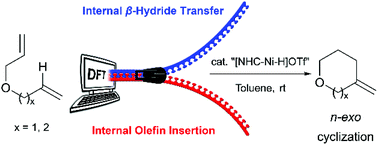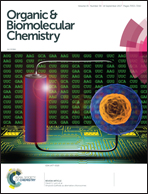The mechanism and regioselectivities of (NHC)nickel(ii)hydride-catalyzed cycloisomerization of dienes: a computational study†
Abstract
Transition metal-catalyzed hydroalkenylation is widely applied in organic synthesis to construct carbon–carbon bonds and synthesize substituted alkenes. In this work, the mechanism and regioselectivities of [(NHC)NiH]+-catalyzed intramolecular cycloisomerization of dienes are studied by density functional theory (DFT) calculations. Through an initial hydride insertion, [(NHC)NiH]+ reacts with the diene substrate to generate the alkyl nickel species. This alkyl nickel species is the resting state of the catalytic cycle, and the hydroalkenylation reaction involves sequential olefin insertion and β-hydride transfer. The selectivity between the possible cycloisomerization products is determined by both the olefin insertion and β-hydride transfer steps. The olefin insertion favors the exo-cyclization due to the high ring strain of the insertion transition states for the endo-cyclization. In the β-hydride transfer step, the hydride transfers to the internal olefin position selectively to avoid the steric repulsions between the bulky NHC ligand and the alkyl substituent of the olefin substrate. This selectivity of β-hydride transfer leads to the n-exo cyclization instead of the (n − 1)-exo cyclization. These mechanistic insights will shed light on the future development of transition metal-catalyzed hydroalkenylation reactions.

- This article is part of the themed collection: Mechanistic Aspects of Organic Synthesis


 Please wait while we load your content...
Please wait while we load your content...